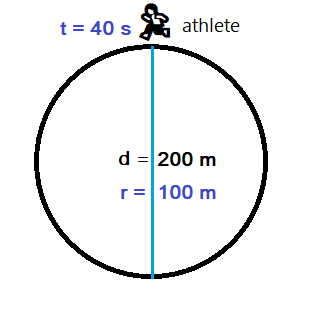An athlete completes one round of a circular track of diameter 200 m in 40 s. What will be the distance covered and the displacement at the end of 2 minutes 20 s?

Solution: Diameter of a circular track d = 200m
Time taken by athlete in complete one round of a circular track t = 40 s
Radius of a circular track r = d/2 = 200/2 = 100 m
Distance covered by athlete in one round of a circular track x = circumference of circular track = 2πr = 2 × 3.14 × 100 = 628 m
Speed = distance covered / time taken = 628 / 40 = 15.7 m/s
Total time taken = 2 min 20 = 140s
Distance covered by athlete at the end of 2 minutes 20 s is ,
Distance = speed × total time taken = 15.7 m/s × 140s = 2198 m ≈ 2200 m
Displacement in 2 minutes (= 120s) will be zero because the athlete will complete 3 rounds (one round in 40s) and at that time the initial position and final position will be the same.
But, after the next 20s, the final position of the athlete will be equal to half of the circumference (one complete round in 40s), so the displacement will be equal to the diameter of the circular track, which is 200 m.
Other NCERT questions solution
Question 2:
Question 3:
Question 4:
Question 5:
A driver of a car travelling at 52 km/ h applies the brakes and accelerates uniformly in the opposite direction. The car stops in 5 s. Another driver going at 3 km/ h in another car applies his brakes slowly and stops in 10 s. On the same graph paper, plot the speed versus time graphs for the two cars. Which of the two cars travelled farther after the brakes were applied?
Question 6:
Table of Contents
An athlete completes one round of a circular track of diameter 200 m in 40 s. What will be the distance covered and the displacement at the end of 2 minutes 20 s? An athlete completes one round of a circular track of diameter 200 m in 40 s. What will be the distance covered and the displacement at the end of 2 minutes 20 s?An athlete completes one round of a circular track of diameter 200 m in 40 s. What will be the distance covered and the displacement at the end of 2 minutes 20 s?
An athlete completes one round of a circular track of diameter 200 m in 40 s. What will be the distance covered and the displacement at the end of 2 minutes 20 s?An athlete completes one round of a circular track of diameter 200 m in 40 s. What will be the distance covered and the displacement at the end of 2 minutes 20 s? An athlete completes one round of a circular track of diameter 200 m in 40 s. What will be the distance covered and the displacement at the end of 2 minutes 20 s?